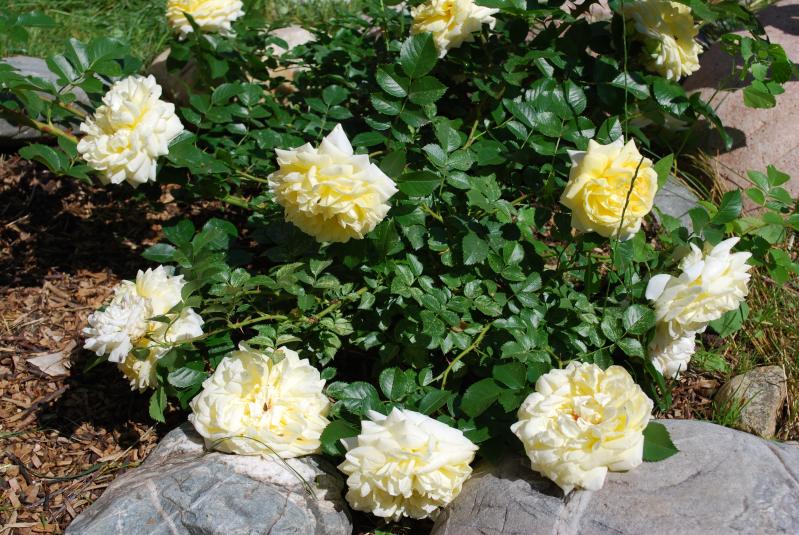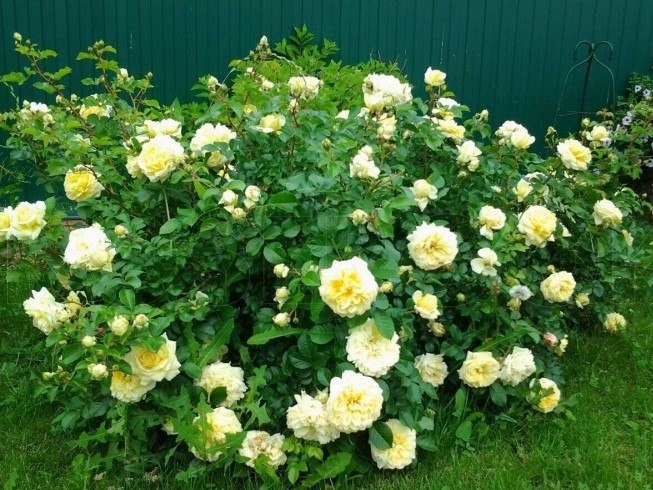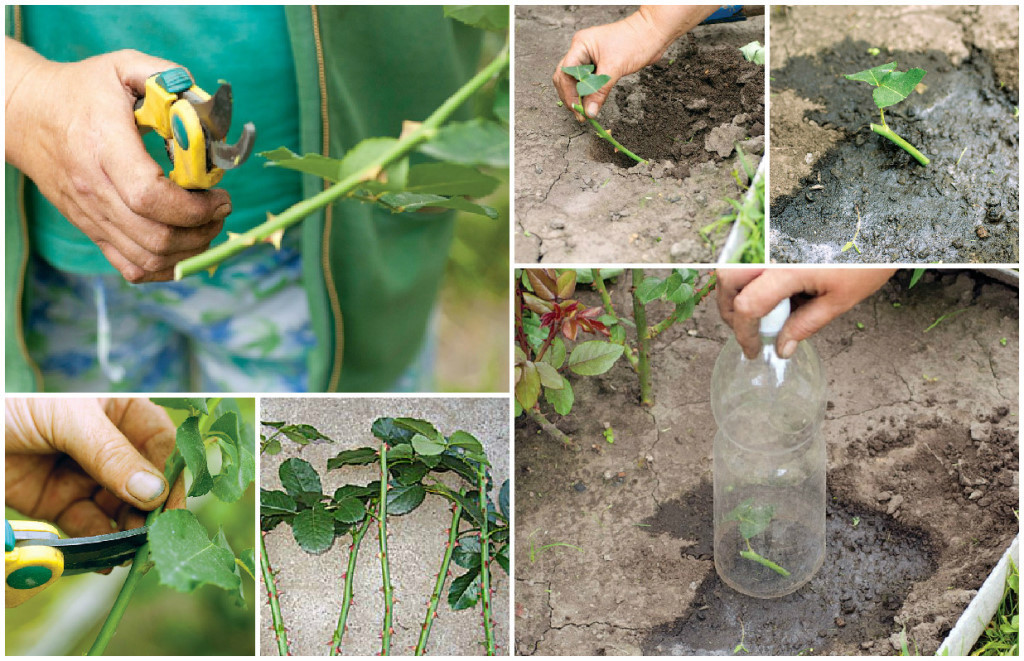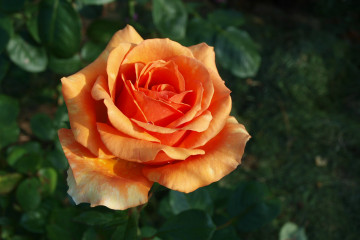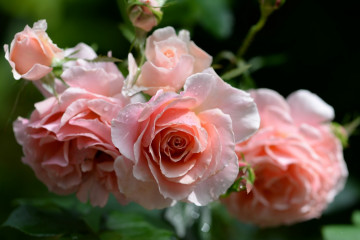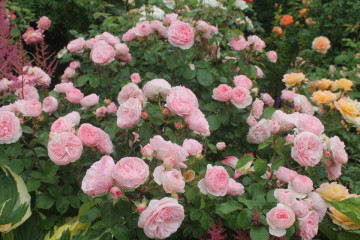Rose Nadia Meillandecor - characteristics of French culture
Content:
The French scrub rose with a subtle yellow shade of petals has been cultivated in Russian gardens for more than 10 years. Of the whole variety of varieties, it stands out for its splendor and extreme undemandingness to soil, wintering and care. The open bush is resistant to frost and disease, and blooms from spring to autumn.
Rose Nadia Meillandecor - what is this variety
The description of the variety says that this rose was officially included in the scrub category several years ago. In 2006, it was presented to the public for the first time at an exhibition in France. An interesting crown and abundant flowering, along with a special yellow-beige shade of petals, immediately attracted the attention of collectors and gardeners to the variety. They say about him: "rose in the style of the Renaissance."
Variety characteristic
The shoots of the bush do not grow too long, 50-60 cm, sometimes up to 80 cm. 3-5 buds are formed at the ends. Double flowers have up to 100 petals. Corolla diameter up to 10 cm. The color of the petals is bright yellow. The buds open slowly, and in blooming they last for 5-6 days. Leaves are large, dark green, shiny. The shoots are densely leafed.
Advantages and disadvantages of the variety
The rose has many advantages:
- pleasant aroma and abundant renewable flowering;
- high growth rate;
- blooms all summer;
- winters well in the regions of southern Russia, the North Caucasus, Stavropol and Krasnodar Territories;
- disease resistance;
- can be grown as a ground cover or standard rose.
Disadvantages:
- shoots can lie under the weight of flowers and leaves, especially after rain;
- needs watering and feeding.
Use in landscape design
The variety combines the properties of climbing, ground cover and scrub roses. Therefore, it can be used as a tapeworm, as well as planted next to a support (pergola, stand, trellis), letting some of the shoots wrap around it, and some of them creep along the surface of the soil.
Growing a flower
You can buy in the nursery a seedling grown from a cuttings or grafted onto a rosehip. Cuttings are 100% original bush that can withstand hibernation only up to -30 ° C, and bushes grafted onto a rose hip winter even at -40 ° C with an agricultural canopy covering the crown.
The seedling can be open-rooted or closed-rooted. Its bark on last year's part should be brown, lignified, but not wrinkled and free of dark spots. Seedlings with open roots are soaked in slightly cool water in the evening in order to plant early in the morning.
Seat selection
A place should be chosen such that a lot of light falls on it, there is a support nearby, and strong winds cannot break the branches.It is best to plant a little on a hill; in the lowlands, due to stagnant water, the roots can rot.
How to prepare the soil and flower for planting
The marking of pits for planting several bushes at once is done at a distance of at least half a meter from each other, as well as from the supports. Any soil with a pH = 5.0-6.5 reaction is suitable. But they prepare it the same way:
- Remove soil from the planting pit.
- Mix it with sand, wood ash, humus.
- Add 50 g of superphosphate and some peat.
Planting procedure step by step
Step-by-step instruction:
- A support is inserted at the bottom, to which the bush will be tied for the first time, so that it does not warp as the soil shrinks.
- Sprinkle open roots with dry root.
- The seedling is lowered into the hole so that the place of the scion is above the soil, and if it is not there, then the neck is buried 5 cm.
- The pit is filled with prepared soil.
- Water and sprinkle abundantly.
- Mulch the soil.
- Light shading is organized for 10 days.
Hilling is raked after the appearance of strong green shoots.
How to organize plant care
It is no coincidence that shrabs are called park roses. They are extremely undemanding to care for, invariably showing lush flowering.
Watering rules and humidity
Watering is needed only when the topsoil under the bush dries well. To do this, take settled water, which warmed up in the open air during the day. When watering, they try to prevent water from falling on the buds, as this can spoil their beauty.
Top dressing and soil quality
The fertilization process consists of three stages.
- Spring. When the buds wake up and bloom, nitrogen fertilizer is applied, which will stimulate the active growth of green mass.
- Summer. With an interval of three weeks, a complex mineral fertilizer is applied with a predominance of phosphorus and potassium, but poor in nitrogen. This is necessary for the formation of buds.
- Fall. In the first decade of September, the last fertilizer is applied - potash. It is necessary to strengthen the bark and prepare the bush for wintering.
Pruning and replanting
Roses are transplanted only as a last resort, since the chances of survival are extremely small. To do this, you need to dig in the bush to a depth of 60 cm.
There are three types of pruning.
- Sanitary. It is carried out in the spring after thawing of the soil. Remove frozen and broken shoots during the winter.
- Formative. It is produced in August. The shoots of the current year are shortened to 40 cm. Too thin and weak lateral branches are removed, since they will not be able to survive the winter.
- Anti-aging. It is performed once every 5 years in the spring. The entire bush is shortened to a height of 30 cm.
Features of wintering a flower
The best shelter for the bush, which will protect the young plant from severe frost and wind, will be a pile of dry leaves, which is covered with agricultural canvas or burlap and pressed along the edges to the ground with stones. They remove such a shelter after the soil has completely thawed.
Blooming rose
The buds bloom gradually, but the bush always looks very elegant. It simultaneously has many buds of different sizes and already fully opened flowers.
The first flowers open in the first half of June. Flowering may occur later due to weather conditions. Color without interruption until September. Then comes a period of rest.
Care during and after flowering
During flowering, it is important to remove all faded buds in a timely manner. This is important, since you cannot get seeds from them for reproduction, but the plant will still try to do this and spend energy. Cut off the dried flowers at the first bud below them. If you cut off long stems all the time, then the bush will be greatly depleted.
What to do if it does not bloom
The lack of buds is a signal of a lack of nutrition.Nadia Meilandekor blooms well in partial shade, so the lack of flowers is rarely the result of strong shading. It is best to feed the bushes once again with a solution of organic or complex mineral fertilizers.
Flower propagation
From a well-grown bush (2-3 years), cuttings can be cut for rooting. They can be immediately planted in a permanent place by choosing it in partial shade, where the sun is only part of the day, and the rest of the time is partial shade.
Cuttings are cut in the first half of June. By this time, the bush should already bloom. The shoot is taken this year with a green bark from 1 cm thick. The crown is given with buds. The optimal cutting size is 10-12 cm.
It is best to root shrubs directly in the open field:
- The cutting should have 3 buds. A larger number of cuttings will not master, and a smaller number reduces the chances of rooting.
- The upper leaves are left, shortening the length by half, and the lower leaves are removed completely along with the thorns.
- The stalk is buried in the ground just above the lower bud at an angle to increase the area of root growth. It is useful to pre-dip the cut in the root.
- Cover the top with a glass jar or a transparent plastic bottle with a cut-off bottom. The bottle cap is not opened.
- Once a day, the jar or bottle is removed to water the cutting.
- If rooting is successful, the jar can be removed after three weeks, as the shoots will start to grow.
Diseases, pests and ways to control them
Aphids and leaf-eating pests can bring the greatest harm to the bush. From them it is recommended to treat the bushes from the beginning of summer in the morning with solutions of Actara or Fitoverm with an interval of 2-3 weeks.
The variety is resistant to disease, but it happens that its shoots are attacked by fungal diseases. For preventive purposes, in the spring, it is worth treating all the bushes with a solution of copper sulfate. There are also good reviews for the drug topaz - a broad-spectrum fungicide.
Many people dream of decorating their site with a French rose scrub. Today there is such an opportunity - the Nadia Meillandecor variety is available commercially. It easily takes root and multiplies, blooms all summer and is unpretentious in care.

